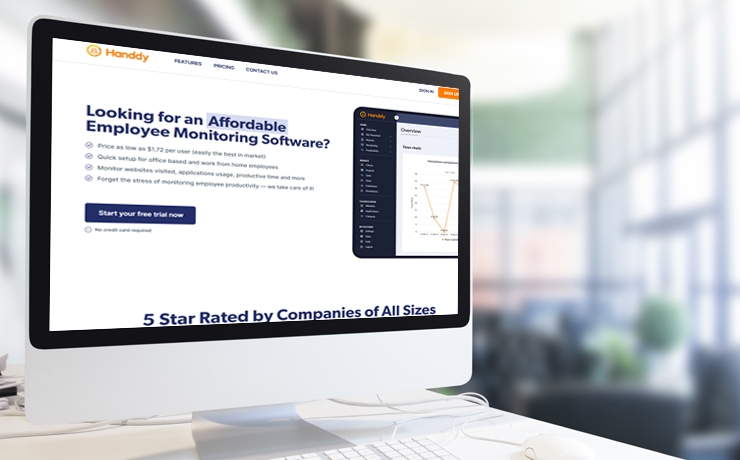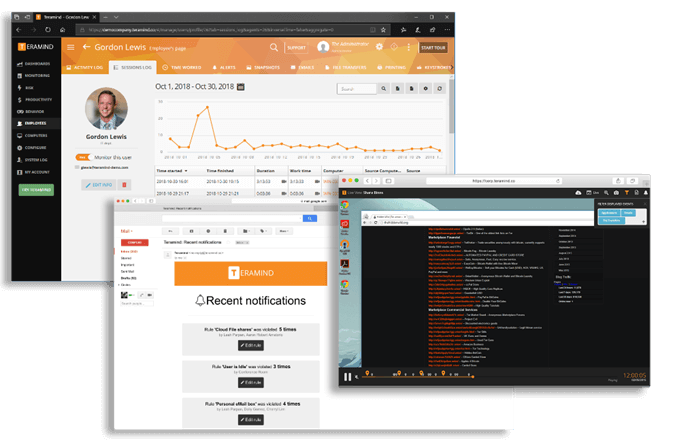Handy Advice For Deciding On Employee Monitoring Company
What Is The Best Employee Monitoring Software? What Do I Need To Know Prior To Deciding It?Employee monitoring software is a software that organizations to monitor and record employees' activities. It allows employers the ability to collect information about a range of factors related to employee behavior. This can include internet use and application usage, keystrokes and screenshots. Employee monitoring software has the primary goal of increasing employee productivity, ensure that company policies are followed and protect confidential information and resolve any security concerns. There are many factors to take into consideration when selecting software for monitoring employees. Remember these essential aspects: Features- Decide which specific features you require in accordance with the needs of your business. The most common features are activities monitoring (including website blocking) Keystroke logging (including the tracking of usage on applications), email monitoring, and reporting. Prioritize features that align with your monitoring goals.
Privacy and Compliance- Make sure that the software follows the ethical and legal guidelines for employee monitoring. Know the relevant laws and regulations in your region. Look for software that provides transparent and configurable settings to respect employee privacy rights.
User-Friendliness- Think about the software's simplicity of use and accessibility. Simple installation and a simple interface will make the installation easier and save you time. Consider a dashboard that is customizable, intuitive reporting tools and other features that let you easily to explore and understand the data you have collected.
Integration and Compatibility- Make sure that the software is seamlessly integrated with your current IT infrastructure and with the platforms you are using, such as operating systems, email clients, project management tools, and collaboration platforms. Compatibility is crucial to ensure seamless monitoring, without disrupting your day-today activities.
Data Security - Check the security measures taken by the software to protect the data collected. Access controls, encryption and secure storage of data and compliance to industry standard security protocols are essential. Examine the security policies of the software.
Scalability- You should consider the software's capacity to grow with the expansion of your business. Select software that is able to expand to meet the demands of your company when you plan on adding more employees or new locations.
Analytics and Reporting The software's reports and analytics features. Take into consideration features that will give a complete view of employee performance, timing allocation, and trends. Customized reports and analytics will assist you in making educated decisions, and identify areas to improve.
Customer Support- Evaluate the quality of customer service offered by the software vendor. Check their availability and technical support. A competent customer support team will provide prompt assistance to any problems that arise.
Cost - Be aware of the pricing structure like a one-time fee or a subscription depending on usage. Understanding the pricing structure and any additional costs like support, updates or extra features is vital. Try to balance the price of your product with its value and features.
Transparency and Communication with Employees - Communicate clearly with your employees about the use of software for monitoring. Define the scope and function of the monitoring in a clear manner. Discuss any concerns they might have, and ensure that they know the ways in which their privacy will be respected.
You can make an informed decision by taking into account these elements and selecting an employee monitoring program that is suitable for your requirements, while respecting the privacy of your employees and meeting the legal standards. See the top time tracking monitoring services for website recommendations.

What Are The Features Of The Employee Monitoring Software? And How Do They Vary?
Software for employee monitoring provides a variety of options to monitor and analyze employee activities. The features that are available may differ among different software options Here are a few commonly used features in the employee monitoring software: Activity MonitoringThis feature records and records employee actions that include websites visited, applications used as well as the files that are accessed and the time spent working on each task. This feature offers a comprehensive overview of time spent by employees at work.
Keystroke Recording Keystroke recorders capture every keystroke pressed by a worker. It helps to spot productivity issues, identify illegal activity, and provide evidence if necessary.
Screenshots and Screen RecordingSome software takes screen shots of employees' computers at regular intervals or records the screens of employees in real time. This is useful for monitoring employee performance, checking compliance or troubleshooting issues.
Internet Usage Tracking: This feature monitors employees' internet activities like the websites they visit as well as search queries that are made and the download of downloaded files. It is used to monitor excessive internet browsing that's not connected to work, security risks, or policy infractions.
This feature tracks all apps used by employees in the workplace. It can help identify inappropriate or excessive usage of applications by providing insight into the applications that are frequently used.
Email Monitoring - This feature allows employers the ability to monitor employee emails including messages received and sent, attachments and email content. It assists in ensuring conformity with policies of the company and prevent leaks of data and also investigate suspicious activity.
File and document tracking - This feature tracks the changes, transfers, and modifications to documents. It protects sensitive data as well as monitors collaboration between documents and ensures compliance with the data security policy.
Remote Monitoring: Employers can to monitor employees remotely or who are at various locations. It allows employers to track their activities and ensure the efficiency of employees regardless of their physical location.
Productivity AnalysisSoftware for monitoring employees typically includes features for productivity analysis that offer insight into the patterns of work performed by employees as well as time allocation and overall levels of productivity. These analyses can help you identify areas for improvement and optimize workflow.
Analytics and Reporting - Rich analytics and reporting tools produce precise reports that include visualizations of data collected. These reports provide useful information about employee performance, time allocation and resource management.
Software that offers features to manage compliance and policies will ensure that the company's policies and regulations are met. Employers can establish and enforce policies pertaining to acceptable computer use as well as internet access and security of data.
Alerts/Notifications: Notifications and alerts inform employers or managers whenever certain events or activities happen. For example, they may warn about excessive internet use attempts to access restricted websites, or other behavior that is suspicious.
It is essential to be aware that these features may differ according to the software you select. Consider features that will aid you in achieving your monitoring goals, and also comply with the ethical and legal standards of your jurisdiction. Have a look at the recommended employee monitoring services for blog advice.

How Does Employee Monitoring Software Adhere To Compliance And Privacy Law?
Adherence to compliance and privacy laws is a critical aspect of employee monitoring software. Here are some ways that employee monitoring software adheres to privacy and compliance laws, even though the legal requirements differ between different jurisdictions. Consent and notification- Many jurisdictions demand an informed consent from employees and require them to be informed about surveillance activities prior to. Employee monitoring software usually includes features that enable employers to clearly communicate their monitoring policies to employees. This could be accomplished through the use of written notices sent to employees, obtaining their consent using consent forms or creating an employee handbook that outlines the monitoring procedures.
Transparent Monitoring policies- Employee monitoring policies promote transparency because they help employees comprehend the type of data that is collected, the goal for monitoring is and in how monitoring activities are carried out. A clear, complete policy will allow employees to better understand their rights in terms of privacy and the boundaries for monitoring.
Data Minimization: To make sure that employee monitoring programs are in compliance with privacy regulations The majority of them follow the principle of data minimization. Data minimization is the process of ensuring that only vital data is collected, retained and not used. This software reduces security risks for privacy by collecting only the data needed for monitoring.
Anonymization and Aggregation- Certain software that monitors employees anonymizes or aggregates information to ensure privacy further. The process of anonymization eliminates personally identifiable information from the stored data. It makes it hard to connect data with an individual. Aggregation combines data from multiple employees to provide insights at an aggregate level, without single out individuals.
Encryption and Secure Data storage Software for monitoring employees places the top priority on security of data. It employs encryption and secure data storage methods. encryption to protect collected data against unauthorised access, breaches, or accidentally disclosed data. It is crucial to secure information during transit as well as at rest.
Access Controls and Restricted Rights In order to ensure compliance, employees monitoring software typically offers access control and rights that are granular. Employers can limit the number of authorized users who have access to monitoring information such as HR staff or designated administrators.
Rights of Employees RightsRespecting the rights of employees means adhering to compliance and privacy laws. Software for monitoring employees typically includes features that permit employees to view their own monitoring information, make corrections or to make complaints. This software allows employees to assert their rights and seek recourse in the event of privacy violations.
Compliance to Data Protection Regulations – Employee monitoring software is designed conformity with the applicable regulations on data privacy, such as the General Data Protection Regulations (GDPR) within the European Union, or the California Consumer Privacy Acts (CCPA) which are in the United States. To ensure compliance, companies must implement the required steps to protect data subjects' rights and guarantee lawful processing.
While employee monitoring software may support compliance efforts in some situations, it's essential to seek legal advice from professionals to stay up-to-date on the relevant laws and regulations within their area of responsibility. To ensure compliance with the privacy and compliance laws an extensive approach is needed that goes beyond software. It should include specific policies and education for employees, as continuous monitoring of compliance. View the most popular employee monitoring company for more info.
